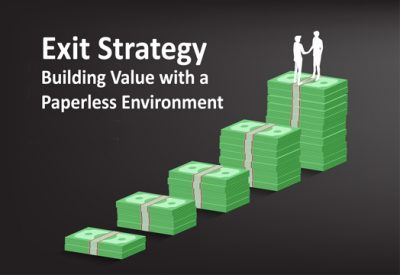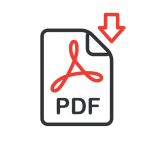Enhancing Your CPA Firm’s Exit Strategy and Value with a Paperless Environment
 With well over 40,000 small-midsized CPA firms across the United States, succession planning is a big concern as Baby Boomers retire. An article published by the American Institute of Certified Public Accountants (AICPA), shows 84% of firms anticipate it being a major issue within the next decade. Selling a CPA firm takes forethought and years of preparation to maximize value, attract qualified potential suiters, and shorten the succession timeframe. Most buyers place a premium on CPA firms operating in a paperless environment. eBizDocs helps businesses transition into a paperless environment and can help your firm build this value. The benefits of operating in a paperless environment are twofold. The first comes in the form of reducing costs and improving efficiencies of your daily operations. The second is capturing a higher valuation in your sales transaction.
With well over 40,000 small-midsized CPA firms across the United States, succession planning is a big concern as Baby Boomers retire. An article published by the American Institute of Certified Public Accountants (AICPA), shows 84% of firms anticipate it being a major issue within the next decade. Selling a CPA firm takes forethought and years of preparation to maximize value, attract qualified potential suiters, and shorten the succession timeframe. Most buyers place a premium on CPA firms operating in a paperless environment. eBizDocs helps businesses transition into a paperless environment and can help your firm build this value. The benefits of operating in a paperless environment are twofold. The first comes in the form of reducing costs and improving efficiencies of your daily operations. The second is capturing a higher valuation in your sales transaction.
Older owners and accounting professionals love paper. They love their folders and three-ring binders. Once workpapers, tax returns, or other accounting engagements are signed off, they print all the documents and hole punch the paper.
If you have a stack of 500 workpapers and find one mistake, you print out one new workpaper, take a hundred workpapers off a ring fastener, and replace the superseded workpaper. It’s easy to see how this approach is costly and inefficient.
But you are not done, because you still must find a place to store all those physical documents. You need lots of filing cabinets and plenty of space. Chances are you also need an off-site storage facility. Once you fill up your onsite space, there is another three or four years-worth of client files needing a home. CPA firm buyers want to pay for value, not a headache that needs sorting out.
Many CPA firms are going paperless. In fact, many CPA firms are already nearly 100% paperless.
If you have an accounting practice for sale, your best potential suitors are looking for a practice that already operates in a paperless environment.
Here are 3 reasons why having a paperless working environment can affect value and result in more money for you, today and when it’s time to sell your accounting practice:
- Conversion time can take 12 to 24 months
It can take anywhere between 12 to 24 months to convert a 100% paper-based accounting practice to a 100% paperless accounting practice. Prospective buyers will not want to deal with a conversion process. The conversion process usually involves scanning and archiving existing documents and possibly transferring financial statements and trial balances to a trial balance software program. Then there is the question of how many prior years need to be archived. This can add several more months to the conversion process. A firm that is already paperless attracts more motivated buyers, and potentially drive up the selling price.
Takeaway… For a firm that is currently not paperless and planning an exit strategy, the ideal timeline is to start the conversion process is at least a year or two before the current owner or partnership group wants to sell.
- Organizing and filing documents is quick and easy
Paper files are more cumbersome to arrange, hole-punch and file in a manila folder or three-ring binder. Electronic files are quick to organize and keep up to date with a click of your mouse. Delegating organizing and filing to administrative assistants and paraprofessionals frees up accounting professionals time so they can focus on generating more billable hours. Some CPAs and firm owners are hesitant to let subordinates file documents for fear of losing or misplacing documents. With a paperless system, it is easy to locate and correct the occasional incorrectly filed document.
Paper based CPA firms need to have an on-site file room, and an off-site storage facility for documents beyond the previous 3 years. It takes an average of 10 minutes to retrieve, copy, and re-file a paper document.
Takeaway… Being able to quickly search for and find electronic files, instead of physical files, is an important consideration to many buyers in accounting practice sales transactions.
- Possible cultural issues from employees
CPA firm employees who worked in a paper environment for multiple years want to stay in their comfort zone. To them, going paperless is a disruption to an established and proven routine. Going paperless could also potentially be a disruption to clients who provide physical documents to a CPA firm. Some clients may not know how to scan or ask their financial institutions for electronic documents. CPA firms need to invest a small amount of time to train clients how to work in a paperless environment.
After the sale, the transition and integration are much easier when the firm has employees who have prior experience working in a paperless environment. Otherwise, there will be a learning curve of several months for workers who spent their careers working with paper.
A best practice for getting user buy-in on implementing a new paperless office is hands-on training. Begin by demonstrating the capabilities of the program, including simple filing, retrieving, creating, and document sharing tasks. Explain how using the system simplifies routine tasks and creates opportunity to focus on more important tasks. Once the firm is comfortable with the paperless basics, process automations, such as workflow, data extraction, and retention, can be added to optimize efficiency.
Takeaway… Prepare different exercises for employees to practice. Include as many scenarios as possible, such as how to process documents initially sent by a client, creating workpapers using Adobe Acrobat or another document software program, how to archive workpapers and documents and how to search documents that have been previously archived.
The American Institute of CPAs estimates 70 percent of CPA firm owners in the United States are, or will become, 65 years old by 2025. Planning a successful exit begins with deciding how to relinquish ownership. There are four general categories most firms ultimately follow.
Common exit strategies
- Turn out the lights
- Selling
- Merging upstream
- Internal succession
Except for “Turning out the lights”, establishing a paperless environment can enhance value and your exit strategy success. When selling a CPA firm, it is recommended to work with deal making professionals who have the transaction knowhow and industry contacts to bring potential suiters to the table. Working with eBizDocs to implement a paperless environment helps you put a compelling opportunity on the table.
Contact eBizDocs and discover how a paperless environment can increase your firm’s value.


